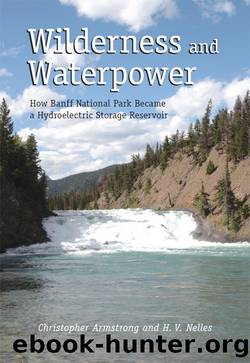Wilderness and Waterpower: How Banff National Park Became a Hydro-Electric Storage Reservoir by Christopher Armstrong

Author:Christopher Armstrong [Armstrong, Christopher]
Language: eng
Format: epub
Tags: Technology & Engineering, Public Policy, Canada, Environmental Economics, Civil, Political Science, Dams & Reservoirs, Business & Economics, Environmental Policy, History, General
ISBN: 9781552386347
Google: N4KLtgAACAAJ
Goodreads: 13586551
Publisher: University of Calgary Press
Published: 2012-10-01T00:00:00+00:00
1941 DAM AT LAKE MINNEWANKA (AUTHOR PHOTO).
The only other public opposition seems to have come from the Alberta Fish and Game Association, whose vice president complained that Calgary Power had deliberately taken on the contract with the Alberta Nitrogen Company as a means of justifying the new development: âIt is, however, a cleverly contrived scheme to wangle something that the Power Company knows that they would otherwise never get.â But the director of the Parks Branch could only reply that if the application was justified by a genuine war emergency, then it would be up to Parliament to decide whether or not to grant it.24
Balanced against these feeble pressures was the support of the Town of Banffâs Advisory Council, which in the past, had often taken an ambivalent position on power development in the park, the dependence on tourism being balanced by the desire for more industrial and commercial growth. The superintendent of Banff National Park reported that many local residents now favoured the plan: âThe local working men are, of course, in favour of the project chiefly because of the possibility of work and wages for another year at least â a very short-sighted and extremely selfish view.â The council advised all Alberta MPs to support the damming of Lake Minnewanka since the availability of low-cost power would be a strong inducement to industry to locate in the region once the war was over.25
With that kind of support, Calgary Power began to act as though a decision in its favour was a foregone conclusion. The director of the Parks Branch complained about the companyâs attitude:
The actions of Calgary Power Companyâs field organization since the negotiations were commenced a few weeks ago no doubt indicate the degree of consideration that the National Parks administration may expect from the company. Even with the knowledge that the chief officials of the company are at Ottawa lobbying for a concession, which, if granted, will be extremely valuable to the company, the field staff ignore the Park Superintendent, notwithstanding the fact that they are well aware that the Superintendent is in full charge of the park and must answer for whatever goes on inside the park boundaries.
This attitude was made plain when the company simply added to its application a proposal to divert Carrot Creek into Lake Minnewanka to increase its storage capacity without even consulting the Parks Branch.26
The redoubtable C. D. Howe remained unwavering in his support of the project. When Alberta MPs complained that not enough new industries had been located in the province, the minister told them that war factories could not be located in Calgary at present owing to the shortage of electrical energy. âWe want all the power that Alberta can produce now, and we can use the whole lot and more, if we can get it,â said the minister. Faced with this implacable resolve, Crerar gave way and advised Howe on November 30 that in view of the ammonia plantâs power needs, Calgary Powerâs application would be granted.27
Download
This site does not store any files on its server. We only index and link to content provided by other sites. Please contact the content providers to delete copyright contents if any and email us, we'll remove relevant links or contents immediately.
Zero to IPO: Over $1 Trillion of Actionable Advice from the World's Most Successful Entrepreneurs by Frederic Kerrest(4302)
Machine Learning at Scale with H2O by Gregory Keys | David Whiting(4192)
Never by Ken Follett(3799)
Harry Potter and the Goblet Of Fire by J.K. Rowling(3776)
Ogilvy on Advertising by David Ogilvy(3515)
Shadow of Night by Deborah Harkness(3306)
The Man Who Died Twice by Richard Osman(2998)
Book of Life by Deborah Harkness(2869)
The Tipping Point by Malcolm Gladwell(2829)
Will by Will Smith(2795)
0041152001443424520 .pdf by Unknown(2785)
My Brilliant Friend by Elena Ferrante(2776)
How Proust Can Change Your Life by Alain De Botton(2746)
Purple Hibiscus by Chimamanda Ngozi Adichie(2652)
How to Pay Zero Taxes, 2018 by Jeff A. Schnepper(2602)
Hooked: A Dark, Contemporary Romance (Never After Series) by Emily McIntire(2502)
Rationality by Steven Pinker(2291)
Borders by unknow(2232)
Can't Hurt Me: Master Your Mind and Defy the Odds - Clean Edition by David Goggins(2229)
